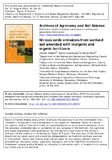Please use this identifier to cite or link to this item:
https://cris.library.msu.ac.zw//handle/11408/497| Title: | Nitrous oxide emissions from wetland soil amended with inorganic and organic fertilizers | Authors: | Masaka, Johnson Nyamangara, Justice Wuta, Menas |
Keywords: | Manure, fertilizer | Issue Date: | 2014 | Publisher: | Taylor and Francis | Series/Report no.: | Archives of Agronomy and Soil Science;Vol. 60; No 10 | Abstract: | Agricultural soils are a primary source of anthropogenic trace gas emissions, and the subtropics contribute greatly, particularly since 51% of world soils are in these climate zones. A field experiment was carried out in an ephemeral wetland in central Zimbabwe in order to determine the effect of cattle manure (1.36% N) and mineral N fertilizer (ammonium nitrate, 34.5% N) application on N2O fluxes from soil. Combined applications of 0 kg N fertilizer + 0 Mg cattle manure ha−1 (control), 100 kg N fertilizer + 15 Mg manure ha−1 and 200 kg N fertilizer + 30 Mg manure ha−1 constituted the three treatments arranged in a randomized complete block design with four replications. Tomato and rape crops were grown in rotation over a period of two seasons. Emissions of N2O were sampled using the static chamber technique. Increasing N fertilizer and manure application rates from low to high rates increased the N2O fluxes by 37–106%. When low and high rates were applied to the tomato and rape crops, 0.51%, 0.40%, and 0.93%, 0.64% of applied N was lost as N2O, respectively. This implies that rape production has a greater N2O emitting potential than the production of tomatoes in wetlands. | URI: | http://hdl.handle.net/11408/497 |
| Appears in Collections: | Research Papers |
Files in This Item:
| File | Description | Size | Format | |
|---|---|---|---|---|
| Prof Masaka 2014 nrm.pdf | 966.88 kB | Adobe PDF |  View/Open |
Page view(s)
14
checked on Jul 25, 2024
Download(s)
4
checked on Jul 25, 2024
Google ScholarTM
Check
Items in MSUIR are protected by copyright, with all rights reserved, unless otherwise indicated.



